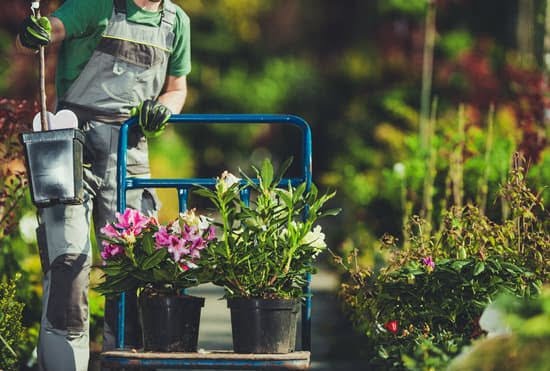Are you looking for creative flower bed ideas for small gardens? Designing a beautiful and functional flower bed in a small garden comes with its own set of challenges. From limited space to finding the right plants, there are several factors to consider when planning a small garden flower bed. In this article, we will explore various strategies and tips to help you create stunning flower beds even in the smallest of garden spaces.
One of the key challenges of designing a flower bed in a small garden is maximizing the limited space available. With careful planning and strategic design, it is possible to create a thriving and visually appealing flower bed that enhances the overall aesthetic of your small garden. From selecting the right plants to utilizing vertical and container gardening techniques, there are numerous ways to make the most out of limited space.
In this article, we will discuss how to assess your garden space, choose suitable plants, incorporate vertical gardening and container gardening techniques, create defined borders, enhance seasonal planting, as well as maintenance and care tips for keeping your small garden flower bed looking its best. Whether you have a tiny urban backyard or a compact courtyard, this article will provide you with valuable insights and inspiration for designing beautiful flower beds in small gardens.
Assessment of Space
When working with a small garden, it’s crucial to make the most of the space you have available for your flower bed. Before you start digging and planting, take the time to assess your space and determine the size and shape of your flower bed. Here are some tips for making the most of limited space:
- Measure your available space: Use a tape measure or a length of string to outline the area where you want to create your flower bed. This will help you visualize how much space you have to work with and plan accordingly.
- Consider the layout: Think about the layout of your garden and how you can incorporate a flower bed into the existing design. Look for opportunities to maximize space, such as along a fence or in a corner that might otherwise go unused.
- Choose a shape that fits: Depending on the layout of your garden, you may want to opt for a square, rectangular, circular, or even irregularly shaped flower bed. Consider how each shape will fit into your existing landscape and complement its surroundings.
By carefully assessing the available space in your small garden, you can determine the size and shape of your flower bed before moving on to selecting plants and designing its layout. With some strategic planning and creativity, even small gardens can become vibrant showcases for beautiful blooms.
Selection of Plants
When it comes to selecting plants for small garden flower beds, it’s important to choose the right flowers that will thrive in limited space while still providing a beautiful and colorful display. Whether you’re working with a tiny urban garden or a compact outdoor space, there are several key factors to consider when choosing the best plants for your flower bed.
Consider Plant Size and Growth Habits
In a small garden, it’s essential to select plants that won’t outgrow their allotted space. Look for compact and dwarf varieties of your favorite flowers, as well as those with a trailing or cascading growth habit. This will help prevent overcrowding and ensure that each plant has enough room to flourish without overshadowing its neighbors.
Choose Low Maintenance Plants
For busy individuals or those new to gardening, selecting low-maintenance plants is crucial for the success of small garden flower beds. Opt for species that are easy to care for and don’t require frequent pruning or deadheading. Drought-tolerant and disease-resistant varieties can also be great choices for minimal upkeep.
Maximize Color and Texture
In a limited space, every plant should make an impact. Choose flowers with vibrant colors and interesting textures to create visual interest in your small garden flower bed. Consider incorporating a mix of annuals and perennials to ensure ongoing bloom throughout the growing season, keeping your flower bed looking beautiful all year round.
By carefully considering the size, maintenance needs, and visual impact of the plants you choose, you can create a stunning flower bed in even the smallest of gardens. With these tips for selecting the right flowers, you can design a flourishing and attractive display that transforms your outdoor space into a blooming oasis.
Vertical Gardening
Maximizing Space With Vertical Flower Beds
When designing a flower bed for a small garden, it is essential to consider utilizing vertical space. Vertical gardening offers a creative solution to maximize limited space by growing plants upward on walls, trellises, and other vertical structures. By incorporating hanging baskets, wall-mounted planters, and climbing vines, you can add depth and visual interest to your small garden while still enjoying the beauty of blooming flowers.
Choosing the Right Plants for Vertical Flower Beds
Selecting the right plants for vertical flower beds in small gardens is crucial to ensure their success. Opt for trailing or vining plants that can gracefully spill over the edges of planters or climb up trellises. Some excellent choices include petunias, nasturtiums, ivy geraniums, and clematis. These plants not only add a pop of color but also create a lush and vibrant display that will enhance the overall appeal of your small garden.
Maintaining Vertical Flower Beds
Maintaining vertical flower beds in small gardens requires regular attention to ensure the health and vitality of the plants. Proper watering, pruning, and fertilization are essential tasks to keep your vertical garden thriving. Additionally, check for any pests or diseases that may affect your plants and address them promptly. With proper care and maintenance, your vertical flower bed will continue to bring joy and beauty to your small garden throughout the season.
By implementing these vertical gardening techniques, you can transform a limited space into a stunning floral display that enhances the charm of your small garden. With careful planning and thoughtful selection of plants, you can create a beautiful vertical flower bed that brings joy all season long.
Container Gardening
When working with a small garden space, incorporating pots and planters can be a great way to add variety and visual interest to your flower bed. These containers allow you to introduce different heights and textures, as well as the flexibility to rearrange your garden design whenever you feel the need for a change.
Here are some creative ways to use pots and planters in your small garden flower bed:
- Utilize hanging baskets: Hang these from walls or fences to create a vertical element in your garden.
- Group different-sized containers: This adds dimension and creates visual appeal.
- Use tiered plant stands: These are perfect for showcasing smaller potted plants while also saving space.
Additionally, when selecting pots and planters for your small garden, consider using lightweight materials such as fiberglass or resin. These materials make it easier to move the containers around when reorganizing your flower bed layout.
Incorporating pots and planters into your small garden flower beds not only adds aesthetic appeal but also offers practical benefits. It allows for easier maintenance of individual plants, provides the option to bring sensitive plants indoors during harsh weather, and gives you the freedom to experiment with different flowers without committing them to a permanent spot in the ground.
Remember that when choosing pots and planters for your small garden’s flower bed, consider the size of the container relative to the space available. Overcrowding with too many containers can make your small garden appear cluttered. With some careful planning and creativity, incorporating pots and planters can truly enhance the beauty of your small garden flower bed.
Edging and Borders
When working with a small garden, creating defined edges and borders for your flower bed is essential to make the most of the limited space. Edging helps to separate the flower bed from the surrounding lawn or walkway, while borders add structure and visual interest to the garden. There are several flower bed edging ideas for small gardens that can help you achieve a polished and well-defined look.
One popular option for edging small garden flower beds is using low-profile materials such as bricks, pavers, or even wood. These materials create a clean and tidy edge without taking up too much space. Additionally, you can also opt for plants with low-growing foliage that naturally form borders around the flower bed, such as dwarf grasses or ground cover plants.
Incorporating curves into the edges of your small garden flower bed can also help maximize space and create an illusion of more room. Curved edges soften the lines of the garden and give it a more organic feel. By combining different types of edging materials or incorporating raised borders, you can add depth and dimension to your small garden flower bed while keeping it visually appealing.
| Flower Bed Edging Material | Potential Plants |
|---|---|
| Bricks | Dwarf grasses |
| Pavers | Ground cover plants |
| Wood | Sedum or Creeping Thyme |
Seasonal Planting
When it comes to small garden flower bed ideas, seasonal planting can play a crucial role in maximizing the color and bloom in your outdoor space. With limited space, it’s important to make the most of every season by carefully selecting plants that will thrive and bring vibrancy to your garden.
One key tip for seasonal planting in small garden flower beds is to focus on plants that offer a variety of blooms throughout the year. This can include early spring flowers such as crocuses and daffodils, summer blooms like petunias and marigolds, and fall favorites such as chrysanthemums and pansies. By planning your flower bed with a mix of seasonal plants, you can ensure continuous color and interest no matter the time of year.
Another important consideration for maximizing color and bloom in small garden flower beds is to pay attention to the heights of the plants you select. Taller plants can add dimension and visual interest, while low-lying ground cover varieties can help fill in any empty spaces. This layering effect creates a dynamic display that changes with each season, keeping your flower bed looking fresh and vibrant.
In addition to traditional flowers, consider incorporating ornamental grasses or evergreen shrubs into your small garden flower bed design. These types of plants can provide structure and texture throughout the year, adding visual appeal even when flowers are not in bloom. By carefully selecting a mix of seasonal blooms, varying plant heights, and incorporating different types of greenery, you can create a stunning display in even the smallest of garden spaces.
| Seasonal Planting Tip | Details |
|---|---|
| Variety of Blooms | Include early spring flowers like crocuses and daffodils, summer blooms such as petunias and marigolds, and fall favorites like chrysanthemums. |
| Layering Effect | Consider the heights of plants for visual interest – taller plants adding dimension while low-lying ground cover provides filling. |
| Incorporate Other Plants | Add ornamental grasses or evergreen shrubs for structure and texture year-round. |
Maintenance and Care
Once you have created your small garden flower bed, it’s important to properly maintain and care for it in order to keep it looking its best. One key aspect of maintenance is regular watering. Since space may be limited in a small garden, it’s crucial to ensure that each plant in the flower bed receives the water it needs. Consider installing a drip irrigation system or using soaker hoses to efficiently water your plants without wasting precious space.
In addition to watering, regular weeding is essential for the health and appearance of your flower bed. With limited space, even a few weeds can quickly overtake the area and detract from the beauty of your flowers. Spend some time each week carefully removing any unwanted plants to keep your small garden flower bed looking tidy.
Finally, fertilizing is also important for maintaining healthy and vibrant flowers in a small garden flower bed. However, be cautious not to over-fertilize, as this can lead to excessive growth and potentially overcrowd the limited space available. Choose a slow-release organic fertilizer and apply it according to the specific needs of the plants in your flower bed.
By committing to regular maintenance and care for your small garden flower bed, you can keep it looking beautiful and thriving throughout the growing season. With proper attention and dedication, your small garden flower bed can become a stunning focal point in your outdoor space.
Conclusion
In conclusion, creating a beautiful and vibrant flower bed in a small garden is certainly possible with the right planning and execution. By carefully assessing the available space, selecting the appropriate plants, utilizing vertical and container gardening techniques, and adding defined borders, anyone can achieve a stunning flower bed in a limited area. It’s important to remember that with some creativity and effort, even the smallest of gardens can be transformed into a colorful oasis.
The key to success with small garden flower beds lies in maximizing the use of every inch of space. By incorporating vertical elements such as trellises or wall-mounted planters, and using containers strategically, you can make the most of limited ground space while still achieving an impressive floral display. Additionally, choosing seasonal plants and maintaining proper care will ensure that your small garden flower bed looks its best year-round.
We hope that this article has inspired you to explore different flower bed ideas for small gardens. Whether you’re dealing with a tiny urban balcony or a compact backyard, there are countless ways to bring beauty and color into your outdoor space. With careful planning and thoughtful design choices, even the smallest garden can become a breathtaking showcase of nature’s splendor. So go ahead and get creative – your perfect small garden flower bed awaits.
Frequently Asked Questions
How Do You Layout a Small Flower Bed?
To layout a small flower bed, start by choosing a suitable location with enough sunlight and good drainage. Then, clear the area of any debris and weeds. Use a shovel to work the soil and add compost or fertilizer as needed.
Next, arrange your flowers in groups by height and color, placing taller plants at the back and shorter ones at the front. Lastly, water the newly planted flowers thoroughly.
How Do You Arrange Flowers in a Small Garden?
When arranging flowers in a small garden, consider the colors, heights, and blooming times of each plant. Group together plants that have similar water and sun requirements. Be mindful of spacing between plants to allow for growth. Mix different varieties to create visual interest and balance within the garden.
How Do I Make My Flower Beds Look Nice?
There are several ways to make flower beds look nice. Start by edging the bed with bricks or stones for a clean look. Choose a variety of flowers that bloom at different times to ensure constant color throughout the season.
Add mulch to suppress weeds and retain moisture in the soil. Regular maintenance like deadheading spent blooms will also keep your flower beds looking neat and attractive throughout the season.

Welcome to my gardening blog! I am passionate about plants and enjoy sharing my knowledge and experiences with others. In this blog, I will write about everything related to gardening, from tips on how to get started to updates on my own garden projects.





